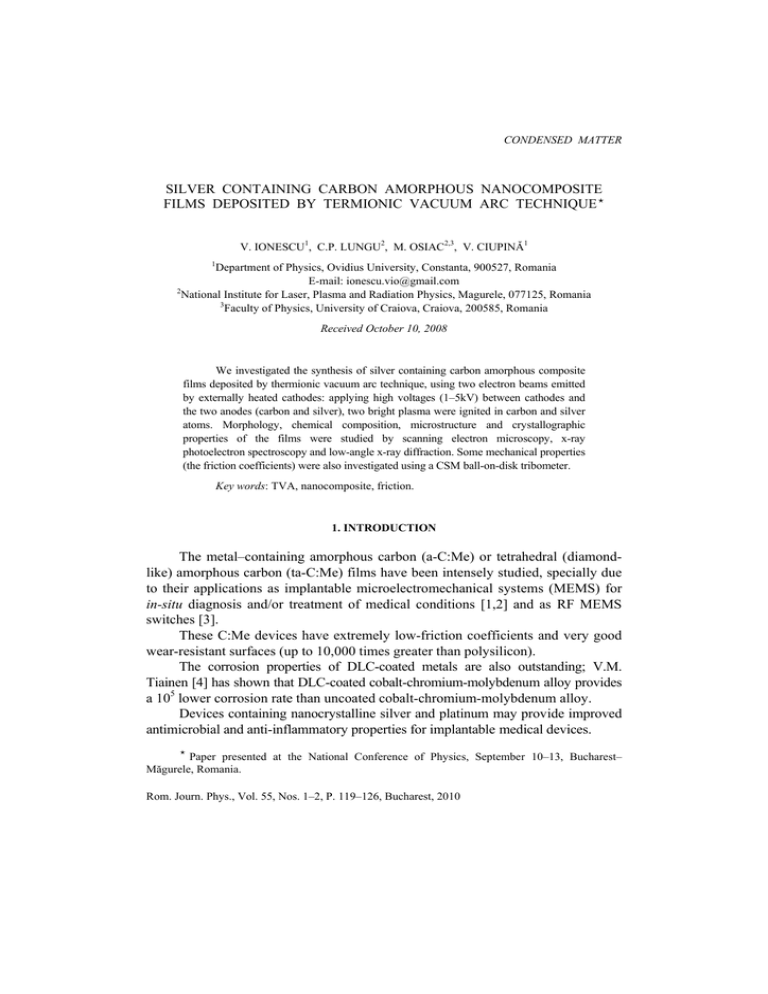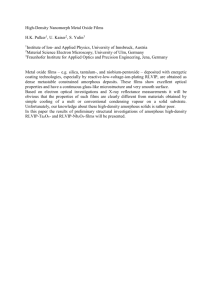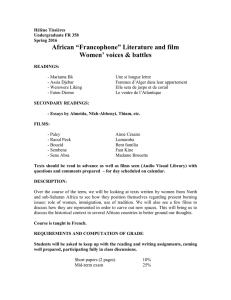SILVER CONTAINING CARBON AMORPHOUS NANOCOMPOSITE
advertisement

CONDENSED MATTER SILVER CONTAINING CARBON AMORPHOUS NANOCOMPOSITE FILMS DEPOSITED BY TERMIONIC VACUUM ARC TECHNIQUEË V. IONESCU1, C.P. LUNGU2, M. OSIAC2,3, V. CIUPINĂ1 1 Department of Physics, Ovidius University, Constanta, 900527, Romania E-mail: ionescu.vio@gmail.com 2 National Institute for Laser, Plasma and Radiation Physics, Magurele, 077125, Romania 3 Faculty of Physics, University of Craiova, Craiova, 200585, Romania Received October 10, 2008 We investigated the synthesis of silver containing carbon amorphous composite films deposited by thermionic vacuum arc technique, using two electron beams emitted by externally heated cathodes: applying high voltages (1–5kV) between cathodes and the two anodes (carbon and silver), two bright plasma were ignited in carbon and silver atoms. Morphology, chemical composition, microstructure and crystallographic properties of the films were studied by scanning electron microscopy, x-ray photoelectron spectroscopy and low-angle x-ray diffraction. Some mechanical properties (the friction coefficients) were also investigated using a CSM ball-on-disk tribometer. Key words: TVA, nanocomposite, friction. 1. INTRODUCTION The metal–containing amorphous carbon (a-C:Me) or tetrahedral (diamondlike) amorphous carbon (ta-C:Me) films have been intensely studied, specially due to their applications as implantable microelectromechanical systems (MEMS) for in-situ diagnosis and/or treatment of medical conditions [1,2] and as RF MEMS switches [3]. These C:Me devices have extremely low-friction coefficients and very good wear-resistant surfaces (up to 10,000 times greater than polysilicon). The corrosion properties of DLC-coated metals are also outstanding; V.M. Tiainen [4] has shown that DLC-coated cobalt-chromium-molybdenum alloy provides a 105 lower corrosion rate than uncoated cobalt-chromium-molybdenum alloy. Devices containing nanocrystalline silver and platinum may provide improved antimicrobial and anti-inflammatory properties for implantable medical devices. Ë Paper presented at the National Conference of Physics, September 10–13, Bucharest– Măgurele, Romania. Rom. Journ. Phys., Vol. 55, Nos. 1–2, P. 119–126, Bucharest, 2010 120 V. Ionescu, C.P. Lungu, M. Osiac, V. Ciupină 2 Ag containing amorphous carbon (a-C:Ag) films are promising for applications in dentistry and orthopaedics [5,6]. The exact mechanism for the action of silver nanoparticles (highly toxic to microorganisms) is unknown, but it is believed that silver ions act by binding to DNA, interfering with electron transport within cells and injuring bacterial enzymes [7]. R.J. Narayan [8] have shown that DLC-silver nanocomposite coatings have antimicrobial efficacy against Staphylococcus aureus bacteria. Several methods for the deposition of C:Ag amorphous carbon nanocomposite coatings have been reported: Pulsed Laser Deposition (PLD) and mass selected ion beam deposition technique used to grow pure a-C:Ag nanocomposites [9,10], Metal Plasma Immersion Ion Implantation and Deposition (MePIIID) [11] and pulsed filtered cathodic vacuum arc deposition (FCVA) [12] for preparation of hydrogen-free DLC-Ag coatings. The present study promotes a novel deposition technique called thermionic vacuum arc (TVA) [13] for deposition of smooth, low-friction, continuous and high sp3 content metal-carbon nanostructured coatings. The purpose of this paper is study the structure and composition of the Ag-containing amorphous carbon composite films deposited by TVA method and correlate the morphological and structural features (Ag grain size and sp3 content of the a-C matrix) with the mechanical properties (the friction coefficient) by variation of the Ag atomic percent in the films. 2. EXPERIMENTAL For the deposition of the nanocomposite C-Ag coatings, we developed a technique which uses two electron beams emitted by two externally heated cathodes of W with the diameters of 1 mm; the beams, accelerated by high anodic voltages, are bombarding simultaneously the graphite anode (a rod of 10 mm in diameter and 150 mm in length) and the other anode consisting in 99.99% purity metal flakes of Ag placed in a TiB2 crucible. Applying high voltages (1–6kV) between cathodes and anodes, two plasmas in vapors of pure carbon and metallic Ag atoms respectively were formed in the high vacuum chamber (the pressure inside the chamber being < 5*10–5 torr). Due to the high energy dissipated in the unit volume plasma, the material was strongly dispersed and completely droplets free. The deposition substrates were steel polished disks, with diameter of 25 mm and 3 mm in thickness, and BK7 optical glass disks with the same diameter and 1 mm in thickness. The substrates were heated at the constant temperature of 200ºC during deposition. The intensities of the heating currents of the cathode filaments were between 40 and 50A. The intensity of the TVA current and voltage for C vapor discharge was Idesc = 1.3–1.4 A and Udesc =170–980 V, respectively; in the case of the discharge in Ag vapor, those value were Idesc = 0.7–0.8A and Udesc = 500–700V. 3 Silver containing carbon amorphous nanocomposite films 121 Fig. 1 – Experimental set-up for C-Ag composite deposition. Deposition rate rd and film thickness d were measured and controlled in situ using a FTM7 quartz microbalance. At first, it was deposited an intermediary layer of Ag (with the thickness of 300 nm), followed by the C-Ag composite layer, having a thickness of 2µm. The friction coefficient measurements were performed using a CSM ball-ondisk tribometer consisting of rotating disks (our samples) sliding on stationary Safire balls (6 mm in diameter) at a sliding speed of 0.1m/s in dry conditions and at the normal load of 1N. Scanning electron microscopy (SEM) analysis were carried out using a Philips model ESEM XL 30 TMP scanning electron microscope operated at 30 kV. The X-ray diffraction (XRD) patterns were obtained using the Shimadzu model 600 powder diffractometer operating with Cu Kα radiation (45 kV, 40 mA) and diffracted beam monochromator, based on a step scan mode with the step of 0.02o 2θ and 0.5 s per step. The low-angle X-ray diffraction analysis were performed to establish the presence of the crystalline phases in the coatings and to calculate the average crystalline size of the particles, using Sherrer’s formula. The X-ray photoelectron spectroscopy (XPS) technique was used in this paper to investigate the variation of the binding energies and intensity for the C1s and Ag3d spectral lines and the atomic percentage of the elements in the surface chemistry of the material analysed in its ”as deposition” states, and after an ionic corodation treatment in Ar gas+ (for 10 minutes). The XPS measurements were recorded with a VG ESCA III MK2 spectrometer system equipped with a monocromated Al k α X-ray source. 122 V. Ionescu, C.P. Lungu, M. Osiac, V. Ciupină 4 3. RESULTS AND DISCUSSIONS In the XRD pattern from Fig. 2, the diffractions at 38.19o, 44.35o, 64.51o and 77.48 2θ can be assigned to (111), (200), (220) and (311) planes of Ag cubic close-packed phase, results that confirm the existence of Ag nanocrystalline phases in the films. We can see also that the peak intensities and full width at half maximum (FWHM) at all the orientations are almost the same, indicating uniform grain size and random orientation. o Fig. 2 – X-ray diffraction pattern of C-Ag nanocomposite film. Ignoring the microstraining effect (which affects the XRD peak width), as a first-order approximation, the average crystalline size can be estimated by the Debye – Scherrer formula [14]: Kλ D= (1) β cos θ where K is a constant (K = 0.91), D is the mean crystalline dimension normal to diffracting planes, λ is the X-ray wavelength ( λ = 0.15406 nm in our case), β in radian is the peak width at half-maximum height, and θ is the Bragg’s angle. The calculated grain size of Ag lie in the range of 15–19 nm in the a-C matrix. G. Matenoglou et al. [9] reported the obtaining of a-C:Ag nanocomposite films consisting in an a-C matrix with crystalline Ag inclusions of a few nm in diameter. The composition of the C-Ag films deposited on glass substrates resulting from XPS quantitative analysis was tabulated in Table 1. It can be seen in this table that for P1_corroded probe, after 10 minutes of argon ionic treatment, Ag atomic percentage increased from 32.2 % to 65.2 %. 5 Silver containing carbon amorphous nanocomposite films 123 Table 1 Composition of the C-Ag films resulting from XPS quantitative analysis C-Ag Probes P1 P 1_corroded P2 P3 P4 P5 C (at%) 67.8 34.8 64.1 63.1 61.8 61.3 Ag (at%) 32.2 65.2 35.9 36.9 38.2 38.7 In the C1s XPS spectra (Fig. 3.a) it was showed that the line peaks of C-Ag probes were similar overall, being localized at approximately 485eV, value that suggests a preponderance of the sp3 carbon bonds in the films. Fig. 3 – XPS spectras of C1s(a) and Ag 3d(b) in a-C:Ag nanocomposite coatings with different metallic contents. With increasing of metal content from 32.2 at% (P1 probe) to 38.7 at% (P5 probe), a small shift in C1s spectral lines was observed, towards lower binding energies; for example: ∆ΕB1_5 = 0.11eV, ∆ΕB1_5 being negative shift in C1s binding energies between P1 and P5 probe spectral lines. This negative shift reveals increased relative content of sp2-coordinated carbon in the a-C matrix [15], which, we believe, should be attributed to the compressive stress that metallic inclusions introduce in the host a-C, being higher with higher metal content in the sample [16]. 124 V. Ionescu, C.P. Lungu, M. Osiac, V. Ciupină 6 Sk.F. Ahmed et al. [17] reported that in the case of the a-C:Ag coatings synthesized by a RF resistive sputtering technique, C1s spectral line peak position shifted also toward the lower energy (sp2 value) as the Ag at.% increases. The XPS spectrum of Ag 3d (Fig. 3.b) consists of two binding energy peaks corresponding to Ag 3d5/2 (368.2 eV) and 3d3/2 (374.2 eV), respectively, which suggests that silver without carbon or oxygen chemical bondings has been incorporated into the a:C matrix. If topmost metallic clusters are covered with a layer of a-C, it should be possible, in principle, to “uncover” them by Ar+ ion bombardment with sufficient energy. From the XPS measurements onto Ar+ ionic treated C-Ag coatings, one should observe the increase of the metallic spectral intensity with respect to the C 1s, as the cover a-C layer gets thinner [18]. This phenomenon was observed in our XPS studies, were we registered an increasing of the Ag 3d5/2 / C1s spectral intensity ratio from 7 to 21 before, and after Ar+ ionic bombardment, respectively. I.R. Videnovic et al. [19] have showed also an increasing of the Au f5/2 / C1s XPS line intensity ratio after 20s of Ar+ ion etching of a-C:H/Au nanocomposite films. From the SEM images presented in Fig. 4, compact micrometric formations of the C-Ag mixture at the surface of the film can be seen. The films with the lowest Ag atomic percent (Fig. 4.a) are uniform from the point of view of particle distributions and dimensions, much smaller (submicron) C-Ag aggregations being present at the surface. Fig. 4 – SEM images of the C-Ag composite probes: (a) – P1, (b) – P2, (c) – P3, (d) – P4, (e) – P5. In Fig. 5 can be observed that the minimum value of friction coefficient µ (0.19) was measured for the probe P1, with the lowest atomic percentage of silver: 32.2%. 7 Silver containing carbon amorphous nanocomposite films 125 Fig. 5 – The variation of the friction coefficient with sliding distance for the nanocomposite probes of C-Ag (a) and comparative representation of the medium friction coefficient for each of the probes analysed (b). DLC-Ag coatings deposited by Electron-Cyclotron Resonance (ECR)-Direct Current (DC) sputtering method presented a coefficient of friction in dry sliding (5N load) decreasing from 0.72 to 0.30, by reduction of the Ag atomic percent in the films from 90% to 50% [20]. 4. CONCLUSIONS The Ag-containing amorphous carbon films with the thickness of 2µm were successfully deposited onto steel and glass substrates using the TVA method. From the typical XRD pattern, the cubic crystalline phase of the silver presented in the films was revealed; the average crystalline size of the Ag particles could be estimated in the domain of 15–19 nm. XPS measurements showed a small negative shift of the C1s spectral lines between probes with different Ag atomic percentages, and an increasing of the Ag 3d5/2 / C1s spectral intensity ratio after Ar+ ionic treatment. The tribological analysis indicated a minimum value of the friction coefficient (0.19) for the probe with lowest atomic percentage of Ag (32.2%) studied. REFERENCES 1. J.R. Sullivan, TA. Friedmann and K. Hjort, MRS Bulletin 26(4), 309–311(2001). 2. P.D. Maguire, T.I.T. Okpalugo and I. Ahmad, Material Science Forum 518, 477–484(2006). 3. C. Orlianges, C. Champeux, A. Catherinot, A. Pothier, P. Blondy, P. Abelard and B. Angleraud, Thin Solid Films 453–454, 291–295(2004). 4. V.M. Tiainen, Diamond Related Mater. 10, 153(2001). 126 V. Ionescu, C.P. Lungu, M. Osiac, V. Ciupină 8 5. R.J. Narayan, Mater. Sci. Eng. C25, 405(2005). 6. G. Dearnaley, J.H. Arps, Surf. Coat. Technol. 200 (2005) 2518. 7. R.B. Thurman and CP. Gerba, CRC Critical Reviews in Environmental Control 18(4), 295– 315(1989). 8. R.J. Narayan, Proceedings of International Symposium on Adhesion Aspects of Thin Films, AH Zeist, Netherlands: VSP, 2004. 9. G. Matenoglou, G.A. Evangelakis, C. Kosmidis, S. Foulias, D. Papadimitriou, and P. Patsalas, Appl. Surf. Sci. 253(19), 8155–8159(2007). 10. I. Gerhards, C. Ronning, U.Vetter, H. Hofsass, H. Gibhardt, G. Eckold, Q. Li, S.T. Lee, Y.L. Huang and M.Seibt, Surface and Coatings Technology 158–159, 114–119(2002). 11. A. Anders, Surf. Coat. and Technol. 93 (2–3), 158–167(1997). 12. S.C.H. Kwok, W. Zhang, G.J. Wan, D.R. McKenzie, M.M.M. Bilek and Paul K. Chu, Diamond and Related Materials 16(4) , 1353–1360(2007). 13. C.P. Lungu, I. Mustata, G. Musa, A. M. Lungu, O. Brinza, C. Moldovan, C. Rotaru, R. Iosub, F. Sava, M. Popescu, R. Vladoiu, V. Ciupina, G. Prodan, N. Apetroaei, J. Optoelectron. Adv. Mater. 8, 74–77(2006). 14. M.V. Zdujic, O.B. Milosevic, L.C. Karanovic, Mater. Lett. 13, 125(1992). 15. N.A. Hastas, C.A. Dimitriadis, D.H. Tassis, Y. Panayiotatos and S. Logothetidis, Appl. Phys. Lett. 79, 3269 (2001). 16. B. Shi, W.J. Meng, L.E. Rehn and P.M. Baldo, Appl. Phys. Lett. 81, 352 (2002). 17. Sk.F. Ahmed, M.-W. Moon and K.-R. Lee, Appl. Phys. Lett. 92, 193502 (2008). 18. I.R. Videnović, “Surface characterization of amorphous hydrogenated carbon thin films containing nanoclusters of noble metals”, Ph.D. thesis, Basel 2003, p. 16. 19. I.R. Videnović, V. Thommen, P. Oelhafen, D. Mathys, M. Düggelin, and R. Guggenheim, Appl. Phys. Lett. 80, 2863(2002). 20. C.P. Lungu, Surface and Coatings Technology 200, 198–202(2005).


